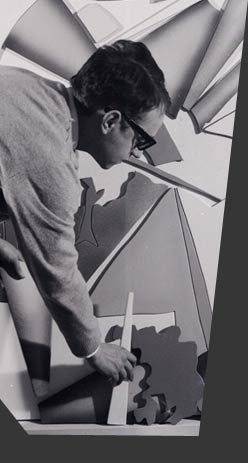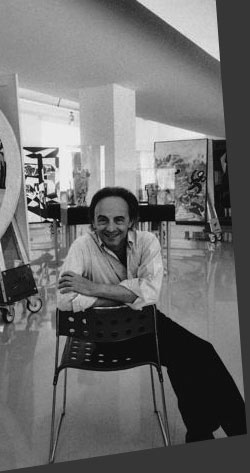Danilo Eccher
UGO NESPOLO: THE YEARS OF THE AVANGUARDE
The Spring of 1968 is an important part of contemporary history, a fever that ran for a long time and everywhere, starting in California then in France and soon across the West. A feverish agitation bearing the name of Herbert Marcuse, Jean-Paul Sartre, Theodor Adorno, Max Horkheimer and the so-called Frankfurt School; a statement of excitement that shook the souls, a primordial fire from which thoughts and actions are radiated, becoming irreconcilable and forming the following decades. The Spring of 1968 was not a sudden and unexpected explosion, was not "lightning in a blue sky", instead it was the disruptive result of a long and arduous path of the first post-war generation, the one born just behind 1945 towards a new dream of social development it was a liberative shout to the beginning of that "Fantasy to power" in order to forget the past and dream the future.
The Spring of 1968 was the sum of the events and rebellions of the previous decade Rockers and Mods, Fluxus, Happenings to the origin of the International Situationists that had among the founders in 1957 also Pinot Gallizio. In the Spring of 1968 is the opening of the personal exhibition of Ugo Nespolo at the Arturo Schwarz Gallery: an unusual one. In an unusual gallery, introduced by an unusual critic, the most ingenious of the French art, the father of the Nouveau Realisme, Pierre Restany. The unusual space comes from the owner's name: not an art merchant but an intellectual scholar of philosophy and Judaism, a great art collector friend of Marcel Duchamp and Man Ray, an amazing provocateur and a sincere surrealist. In a gallery where you search the thoughts rather than present the art work, where poetry is the master, where enchantment and surprise proceeds side by side. In such a crooked space even Ugo Nespolo's exhibition is proposed obliquely.
Infact Tommaso Trini writes "as in a general meeting of his objectual research Ugo Nespolo takes possession of the Schwarz Gallery; actually the old pictures testify the visual writing, inconsistent, with clustered works, laying on the floor, hanging from the ceiling, piled one on each other in a crazy expressive congestion with disquieting results but at the same time amusing: Trini recalls the "general meeting" of students and workers in those days in factories and universities, frantic and throbbing places of an unknown collective enthusiasm that represents a concentration of rebellion with many valves of irony, Not the natural and pure environment confirmed years before with Minimal Art or with Land Art and Arte Povera, hard-won in the same period, but a place of uncertainty and of possibility. In his catalog Pierre Restany writes: Nespolo does not impose as an intermediate, total and illuminating revelation, but appears as a subtle intermediate zone, midway between the separation of the object and its direct appropriation. (...) Nespolo's objects and forms that live in conditional and not in indicative".
There is the acceptance of a lateral that must not be confused wit intellectual shyness but on the contrary as a desire to deform the visual cone and add unusual prospects: "With an intellectual mediation that distinguishes him from other elementary structural, Nespolo works on the reason of things rather than on the things themselves. So, the exhibition of Ugo Nespolo that opens on the 5th of May 1968 at the Schwarz Gallery in Milan, looks like a forest of thoughts and ideas, a dense vegetation of intellectual games, jokes and tricks of the mind that surprise the eye, forcing to torsions and to suddenly focus. It accentuates in this way a linguistic process that had already characterized the poetry of Nespolo since the beginning: starting from the exhibition at the Punto Gallery in Turin in 1966, to the Fluxus performances in the halls of the GAM in Turin in 1967, or in the same year at the Bertesca Gallery in Genoa; an irreverent attitude of amused lightness, a constant and gentle smile that surrounds all his work, making them soft, joyful but never "carefree". "We need to demythologize and lighten art, making it a natural way of extension and completion of everyday life. Not to impoverish, to deny or to lower it: in contrary to redeem it in its true nature, in its real dimension, as a spontaneous game, truly and naturally fun" writes Enrico Crispolti in 1972. In fact, at the Schwarz Gallery, among all the paintings exposed, what stands out is a work composed by two wooden cylinders covered with canvas jute and tied together with a long cannabis rope.
It appears like a jumble of an old yoyo and a huge telephone for children, a huge game off scale, dressed with cheap and conceptual clothing, a
violent semantic short-circuit between the memory of a harmless child object, playful and a gaunt language, rude and grimly symbolic. This area of ambiguity and surprise is long, a metaphorical environment where Nespolo decided to live, as Paul Ricoeur would say, its on a crest of a hovering truth where Nespolo placed his works and on an open stage where Nespolo started his recitals and wore his masks. The final outcome of Dada as Lea Vergine called it, is an artist who has chosen the suffering of the doubt under a mockery guise.
Forty-eight years after that Spring of 1968, the GAM of Turin is trying to repeat the artistic process that made the laterality and irony his emblem. In this context the analysis of those years of early poetry allowed a more consistent and reliable mapping of a recent history of Italian art where with distractions and omissions, and some complacency. And so Nespolo is a real " Surprise", a little adventurous path that winds along a strenuous truth, that touches the landscapes of a visionary too childish. The carpenter has loosen his grip on the objects in order to embrace useless coloured dice, the language of interlocking that will determine the artistic physiognomy of Nespolo.
Compose and de-compose, disseminate and reorder, confuse and suggest, a continuous game of surprises and traps, a kind of logic dyslexia that is evidenced in all the work on the language that can be synthesized in "Verità e Menzogna" dated 1968 that reproduce the process of verifiability of syllogism through the mechanism of the pulleys.
A work extraordinarily foolish achieved by the reworking of studies conducted in the early twentieth century of the mathematician Annibale Pastore and of the English Alan Turing, who thrilled even Alighiero Boetti. A work where the equations of logical truth for a philosophical syllogism are reduced to their shape: "the way and the figure of a syllogism determine uniquely its form and the form of a syllogism, from a logical point of view, its the most important aspect. The validity or the invalidity of a syllogism depends only on its shape and is completely independent of its specific contents or treated subject.". So, the logical equations True-False are strongly made in a series of mechanical drawings of Nespolo, that play the role of a repetitive game, innocuous and superficially decorative.
Its an intellectual process that Nespolo uses in those same years, from 1966 to 1969 with the movies, producing bizarre projects with his artist colleagues (Boetti, Merz, Pistoletto). Or involving leading cultural figures (Allen Ginsberg). That of Nespolo is a stream of thoughts, an appearance and a collapse, a constant and restless flow, an intermittent showing; art that plays with masks and disguises, that seems to skate on the surface that all of a sudden splits open to swallow every glance.
Ugo Nespolo' "Surprise" is not only detectable in his previous works, its all his art that invites to curiosity and to the game, to immediate pleasure and to a deep reason; it's the cheerful procession of the Carneval of Rio de Janeiro with its erotic colors and favelas.
(From the book: Nespolo The years of the Avantgarde, Surprise, Galleria d'Arte Moderna, Gam Torino, 2013, FMR-ARTE', Bologna)



